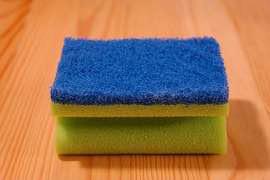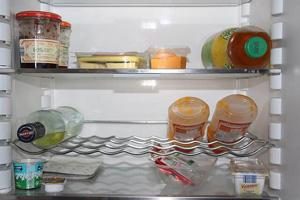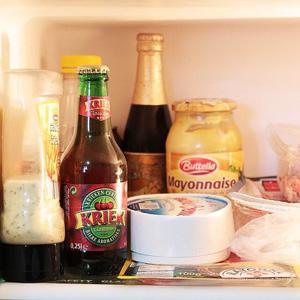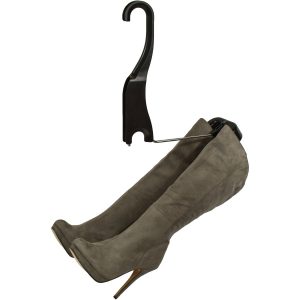 Refrigerators: Whether yours is on the smaller side or a large double-wide, it’s one of the toughest working appliances in our homes. Your household uses it multiple times a day and night, and even when it’s not in direct use, it’s still working: storing and keeping your food cool and fresh.
Refrigerators: Whether yours is on the smaller side or a large double-wide, it’s one of the toughest working appliances in our homes. Your household uses it multiple times a day and night, and even when it’s not in direct use, it’s still working: storing and keeping your food cool and fresh.
Let’s delve into how to get it extra clean and nicely organized.
Without a doubt, a clean fridge will keep your food fresher for longer, which is both healthier on your eating habits and your finances.
ASSESS THE SITUATION
To begin, pick a time where your fridge is at its emptiest. A good deep cleaning time is not, therefore, when you’ve come home from a huge run to the grocery store.
First, check the items that are in the fridge. If anything has gone bad, get rid of it — toss it into the garbage disposal, recycle any containers that can be, throw it out so that it’s no longer in your fridge.
Check expiration dates, see if there’s anything lurking in the furthest nooks and crannies. This is also a good time to see if there’s anything that you just don’t want anymore. Has that fancy mustard been sitting there unopened for a year? It might be time to toss it so that it stops taking up space.
CLEANING THE OUTSIDE
Now, let’s get some cleaning solutions and rags ready.
No need for any special cleansers here (unless you’ve got a stainless steel appliance, which we’ll deal with in a bit). For the outside of the fridge, you can simply pour a bit of dishwashing liquid into some warm water.
Wipe the doors, and pay extra attention to the door handles. These get lots of everyday use, so give them a thorough scrub.
 If your fridge is stainless steel, make sure you use a product formulated just for that. Wipe in the direction of the grain — not against it.
If your fridge is stainless steel, make sure you use a product formulated just for that. Wipe in the direction of the grain — not against it.
Don’t forget to tackle the top of the fridge. If you’re storing items on the top of the fridge as most of us do, this is a good time to take everything off. Put it on a table or a countertop. Wipe the top thoroughly, and then take a look at the items that you’ve been keeping up there. Give them a good wipe, make sure they’re clean and dust-free, and then also assess whether your top-of-the-fridge storage system is a good one. Maybe you’re constantly reaching for something that’s further in the back? Or maybe there’s too much stuff up there? If so: Bring the items that you’re reaching for constantly to the forefront. Find other storage spots for items that you don’t use every day, or recycle/get rid of items that no longer have a place in your life.
Now open up the fridge, and tackle the door seals. These are prime spots for crumbs to collect. Once you’re done, run a dry rag across the seal so that they’re nice and dry.
CLEANING THE INSIDE
For a truly deep clean, we’re going to get serious here. Empty your fridge contents into a cooler. Next, turn off the power (whether by unplugging the cord if you have access to it, or by using your fuse box).
Take out the shelves and crisper containers. It’s best to wash these once they’re at room temperature, so while they’re warming up, we’ll deal with the interior of the fridge.
Mix up a solution of baking soda and water: 2 tablespoons of baking soda in ~4 cups of warm water. (It’s best to not use soap on your fridge interior because food can absorb its soap and chemicals.)
Clean the interior of the fridge carefully with your solution, and then dry it with a clean rag or towel. For tough stains, let these soak in the baking soda solution for up to 10 minutes, then wipe away.
Use a fresh batch of the baking soda-water solution to clean the shelves and containers. Rinse them off thoroughly, and then dry them before installing them back inside.
ORGANIZATION
Next, let’s talk about organization. Think like with like, and parcel out your particular fridge according to sections that make most for the food that you store in it. For those of you with a fondness for jams, for example, group them all together so that you’re not searching blindly for that one particular fig when a taste for it strikes.
You can also go a step further, and label the shelves so there’s no doubt about what should go where.
Good general guidelines include:
- Dairy — cheese, eggs
- Fruits
- Veggies
- Proteins — lunch meat, tofu
- Bread, bagels, starches
- Condiments — side shelves are usually great for these, but sometimes certain bottles/jars don’t fit there, so store them together in a spot that makes the most sense
- Sweets
- Leftovers — good to have a dedicated spot for these, otherwise you’ll forever be trying to jam them into random spots where they may or may not fit
Figure out what the best spots for you and your family are; and once your fridge is clean, dry, and plugged back in, put all your items back in according to your new organizational system. In fact, it may be helpful to have such a chart in a visible spot on the front or side of your fridge — especially if multiple people use it on a daily basis.
EVERYDAY MAINTENANCE
Place a box of baking soda with either an open top or sides in the back of your fridge and in your freezer, and replace it once a season. Deal with spills right as they happen. Grab a moist rag and wipe them right up. Otherwise, they will dry, congeal, drip onto other items. Those few seconds of immediate reaction will save you time down the road.
Another good rule of thumb is to wipe the tops and rims of jars and bottles. You don’t want your ketchup rim to build up over time to a point where it’s difficult to get any ketchup up. That’s not just unpleasant to deal with, but unsanitary. Dealing with it as you go will also save you the hassle of picking up sticky jars, as well as cross-contamination.
Expert tip: Place items that may leak, such as a container of berries, onto a dish with a rim so that any liquid doesn’t drip onto the shelf or items below. Definitely do this anytime you defrost meat: Grab a rimmed plate that’s large enough or a glass baking dish with raised sides.  Leftovers are best stored in airtight containers. These will not only prevent spills but also help prevent odors.
Leftovers are best stored in airtight containers. These will not only prevent spills but also help prevent odors.
If you do find yourself plagued with an odor, try one of two things:
- Spread a small box of baking soda out onto a large plate or baking sheet and place it in your fridge;
- Sprinkle coffee grounds onto a small plate or into a bowl. Both the baking soda and coffee grounds are great for absorbing odors.
How often should you do a deep clean? Some experts recommend once a season; others twice a year. It truly depends on what your situation is: If your fridge is a very highly trafficked area, then set a deep clean on your to-do list once a quarter. If you travel a lot and eat out often, you may need a deep clean twice a year.


